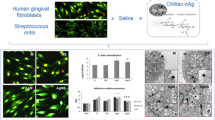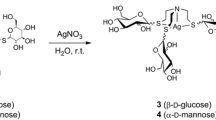Abstract
The aim of this study was to investigate the in vitro effects of low concentrations of chlorhexidine (CHX) on the proliferation of Streptococcus sobrinus (ATCC 33478) and primary human gingival fibroblasts (HGF). Liquid cultures of bacteria or human gingival fibroblasts were exposed to CHX concentrations ranging from 0.07 to 40 μM in microtiter plates at 37°C for 24 h. Bacteria or cells grown without CHX served as controls. The effects of CHX were determined either by measurements of the optical density (OD) of bacterial cultures or by evaluation of cell growth with the DNA-intercalating fluorescent stain H33342 in comparison to untreated controls. Results were evaluated calculating means and standard deviations. Data were statistically analyzed by an ANOVA using Post Hoc tests (p<0.005). No growth inhibition of S. sobrinus was found at concentrations between 0.07 and 0.15 μM CHX, whereas 0.3 μM CHX led to an elongated (2 h more) lag phase and 0.6 μM CHX induced a lag phase of 4 h more and a minor inclination of the curve in the log phase. Concentrations of CHX≥1.25 μM completely inhibited growth of S. sobrinus. On the contrary, CHX showed no significant effect on growth of HGF at concentrations ≤5 μM. A slight growth inhibition was only observed at a concentration of 5 μM. CHX-concentrations of 10 and 20 μM reduced cell growth to 88 or 75% of control assays. Data analysis showed that overall treatment effects were highly significant (p<0.005). Our data reveal that chlorhexidine inhibits proliferation of S. sobrinus even at very low concentrations while concentrations of CHX≤5 μM are not cytotoxic to human gingival fibroblasts.


Similar content being viewed by others
References
Arweiler NB, Netuschil L, Reich E (2001) Alcohol-free mounthrinse solutions to reduce supragingival plaque regrowth and vitality. A controlled clinical study. J Clin Periodontol 28:168–174
Babich H, Wurzburger BJ, Rubin YL, Sinensky MC, Blau L (1995) An in vitro study on the cytotoxicity of chlorhexidine digluconate to human gingival cells. Cell Biol Toxicol 11:79–88
Bonesvoll P (1977) Oral pharmacology of chlorhexidine. J Clin Periodontol 4:49–65
Botelho MG (2000) The minimum inhibitory concentration of oral antibacterial agents against cariogenic organisms. Microbios 103:31–41
Cline NV, Layman DL (1992) The effects of chlorhexidine on the attachment and growth of cultured human periodontal cells. J Periodontol 63:598–602
Decker EM, Weiger R, von Ohle C, Wiech I, Brecx, M (2003) Susceptibility of planktonic versus attached Streptococcus sanguinis cells to chlorhexidine. Clin Oral Invest (in press)
Grönroos L, Mättö J, Saarela M, Luoma AR, Luoma H, Jousimies-Somer H, Pyhälä L, Asikainen S, Alaluusua S (1995) Chlorhexidine susceptibilities of mutans streptococcal serotypes and ribotypes. Antimicrobial Agent and Chemotherapy 39:894–898
Hansel C, Leyhausen G, Mai UEH, Geurtsen W (1998) Effects of various resin composite (co)monomers and extracts on two caries-associated micro-organisms in vitro. J Dent Res 77:60–67
Helgeland K, Heyden G, Rølla G (1971) Effect of chlorhexidine on animal cells in vitro. Scand J Dent Res 79:209–215
Hidalgo E, Dominguez C (2001) Mechanisms underlying chlorhexidine-induced cytotoxicity. Toxicol In Vitro 15:271–276
Kohler B, Bjarnason S (1992) Mutans streptococci, lactobacilli and caries prevalence in 15 to 16 year olds in Goteborg. Part II. Swed Dent J 16:253–259
Koontongkaew S, Jitpukdeebodintra S (1995) Interaction of chlorhexidine with cytoplasmatic membranes of Streptococcus mutans GS-5. Caries Res 29:413–417
Luoma H, Murtomaa H, Nuuja T, Nyman A, Nummkoski P, Ainama J, Luoma AR (1978) A simultaneous reduction of caries and gingivitis in a group of school-children receiving chlorhexidine-fluoride applications. Results after 2 years. Caries Res. 12:290–298
Mariotti AJ, Rumpf DAH (1999) Chlorhexidine-induced changes to human gingival fibroblast collagen and non-collagen protein production. J Periodontol 70:1443–1448
Netuschil L, Weiger R, Preisler R, Brecx M (1995) Plaque bacteria counts and vitality during chlorhexidine, meridol and listerine mouthrinses. Eur J Oral Sci 103:355–361
Pesonon T, Holmalahti J, Pohjola J (1995) Determination of chlorhexidine in saliva using high-performance liquid chromatography. J Chromatogr B Biomed Appl 665:222–225
Portenier I, Haapasalo H, Ørstavik D, Yamauchi M, Haapasalo M (2002) Inactivation of the antibacterial activity of iodine potassium iodide and chlorhexidine digluconate against Enterococcus faecalis by dentin, dentin matrix, type-I collagen, and heat-killed microbial whole cells. J Endodont 28:634–637
Pucher JJ, Daniel JC (1993) The effects of chlorhexidine digluconate on human fibroblasts in vitro. J Periodontol 62:526–532
Rølla G, Løe H, Schiøtt CR (1971) Retention of chlorhexidine in the human oral cavity. Archs Oral Biol 16:1109–1116
Salem AM, Adams D, Newman HN, Rawle LW (1987) Antimicrobial properties of two aliphatic amines and chlorhexidine in vitro and in saliva. J Clin Periodontol 14:44–47
Shani S, Friedman M, Steinberg D (2000) The anticariogenic effect of amine fluorides on streptococcus sobrinus and glucosyltransferase in biofilms. Caries Res 34:260–267
Shapiro S, Giertsen E, Guggenheim B (2002) An in vitro oral biofilm model for comparing the efficacy of antimicrobial mouthrinses. Caries Res 36:93–100
Spijkervet FK, van Saene JJ, van Saene HK, Panders AK, Vermey A, Fidler V (1990) Chlorhexidine inactivation by saliva. Oral Surg Oral Med Oral Pathol 69:444–449
Steinberg D, Rothman M (1996) Antibacterial effect of chlorhexidine on bacteria adsorbed onto experimental dental plaque. Diagn Microbiol Infect Dis 26:109–115
Acknowledgments
The authors would like to thank Mr. Oliver Staperfeld and Mr. Dennis DiJulio for their excellent technical assistance.
Author information
Authors and Affiliations
Corresponding author
Rights and permissions
About this article
Cite this article
Dogan, S., Günay, H., Leyhausen, G. et al. Effects of low-concentrated chlorhexidine on growth of Streptococcus sobrinus and primary human gingival fibroblasts. Clin Oral Invest 7, 212–216 (2003). https://doi.org/10.1007/s00784-003-0226-3
Received:
Accepted:
Published:
Issue Date:
DOI: https://doi.org/10.1007/s00784-003-0226-3




